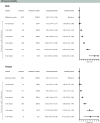Range of Risk Factor Levels: Control, Mortality, and Cardiovascular Outcomes in Type 1 Diabetes Mellitus
- PMID: 28416524
- PMCID: PMC5400410
- DOI: 10.1161/CIRCULATIONAHA.116.025961
Range of Risk Factor Levels: Control, Mortality, and Cardiovascular Outcomes in Type 1 Diabetes Mellitus
Abstract
Background: Individuals with type 1 diabetes mellitus (T1DM) have a high risk of cardiovascular complications, but it is unknown to what extent fulfilling all cardiovascular treatment goals is associated with residual risk of mortality and cardiovascular outcomes in those with T1DM compared with the general population.
Methods: We included all patients ≥18 years of age with T1DM who were registered in the Swedish National Diabetes Register from January 1, 1998, through December 31, 2014, a total of 33 333 patients, each matched for age and sex with 5 controls without diabetes mellitus randomly selected from the population. Patients with T1DM were categorized according to number of risk factors not at target: glycohemoglobin, blood pressure, albuminuria, smoking, and low-density lipoprotein cholesterol. Risk of all-cause mortality, acute myocardial infarction, heart failure hospitalization, and stroke was examined in relation to the number of risk factors at target.
Results: The mean follow-up was 10.4 years in the diabetes group. Overall, 2074 of 33 333 patients with diabetes mellitus and 4141 of 166 529 controls died. Risk for all outcomes increased stepwise for each additional risk factor not at target. Adjusted hazard ratios for patients achieving all risk factor targets compared with controls were 1.31 (95% confidence interval [CI], 0.93-1.85) for all-cause mortality, 1.82 (95% CI, 1.15-2.88) for acute myocardial infarction, 1.97 (95% CI, 1.04-3.73) for heart failure hospitalization, and 1.17 (95% CI, 0.51-2.68) for stroke. The hazard ratio for patients versus controls with none of the risk factors meeting target was 7.33 (95% CI, 5.08-10.57) for all-cause mortality, 12.34 (95% CI, 7.91-19.48) for acute myocardial infarction, 15.09 (95% CI, 9.87-23.09) for heart failure hospitalization, and 12.02 (95% CI, 7.66-18.85) for stroke.
Conclusions: A steep-graded association exists between decreasing number of cardiovascular risk factors at target and major adverse cardiovascular outcomes among patients with T1DM. However, risks for all outcomes were numerically higher for patients with T1DM compared with controls, even when all risk factors were at target, with risk for acute myocardial infarction and heart failure hospitalization statistically significantly higher.
Keywords: cardiology; cardiovascular diseases; diabetes mellitus; heart failure; mortality/survival; risk factors.
© 2017 The Authors.
Figures


References
-
- Nathan DM, Cleary PA, Backlund JY, Genuth SM, Lachin JM, Orchard TJ, Raskin P, Zinman B Diabetes Control and Complications Trial/Epidemiology of Diabetes Interventions and Complications (DCCT/EDIC) Study Research Group. Intensive diabetes treatment and cardiovascular disease in patients with type 1 diabetes. N Engl J Med. 2005;353:2643–2653. doi: 10.1056/NEJMoa052187. - PMC - PubMed
-
- Lind M, Svensson AM, Kosiborod M, Gudbjörnsdottir S, Pivodic A, Wedel H, Dahlqvist S, Clements M, Rosengren A. Glycemic control and excess mortality in type 1 diabetes. N Engl J Med. 2014;371:1972–1982. doi: 10.1056/NEJMoa1408214. - PubMed
-
- Livingstone SJ, Levin D, Looker HC, Lindsay RS, Wild SH, Joss N, Leese G, Leslie P, McCrimmon RJ, Metcalfe W, McKnight JA, Morris AD, Pearson DW, Petrie JR, Philip S, Sattar NA, Traynor JP, Colhoun HM Scottish Diabetes Research Network epidemiology group; Scottish Renal Registry. Estimated life expectancy in a Scottish cohort with type 1 diabetes, 2008-2010. JAMA. 2015;313:37–44. doi: 10.1001/jama.2014.16425. - PMC - PubMed
-
- Gaede P, Vedel P, Larsen N, Jensen GV, Parving HH, Pedersen O. Multifactorial intervention and cardiovascular disease in patients with type 2 diabetes. N Engl J Med. 2003;348:383–393. doi: 10.1056/NEJMoa021778. - PubMed
-
- Bittner V, Bertolet M, Barraza Felix R, Farkouh ME, Goldberg S, Ramanathan KB, Redmon JB, Sperling L, Rutter MK BARI 2D Study Group. Comprehensive cardiovascular risk factor control improves survival: the BARI 2D Trial. J Am Coll Cardiol. 2015;66:765–773. doi: 10.1016/j.jacc.2015.06.019. - PMC - PubMed
MeSH terms
LinkOut - more resources
Full Text Sources
Other Literature Sources
Medical

